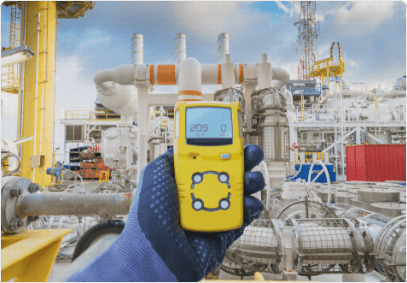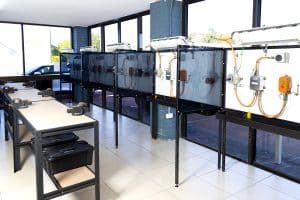Not known Factual Statements About Roar Solutions
Not known Factual Statements About Roar Solutions
Blog Article
The Facts About Roar Solutions Uncovered
Table of ContentsRoar Solutions Things To Know Before You Get ThisSome Ideas on Roar Solutions You Should KnowThe Facts About Roar Solutions Uncovered
In order to secure installments from a potential explosion a technique of evaluating and classifying a possibly hazardous area is called for. The purpose of this is to ensure the correct choice and installment of tools to inevitably protect against a surge and to make certain security of life.
(https://www.anobii.com/en/01749dcc41232b575a/profile/activity)
No tools ought to be mounted where the surface area temperature of the equipment is better than the ignition temperature level of the provided hazard. Below are some usual dirt dangerous and their minimum ignition temperature. Coal Dirt 380C 225C Polythene 420C (melts) Methyl Cellulose 420C 320C Starch 460C 435C Flour 490C 340C Sugar 490C 460C Grain Dust 510C 300C Phenolic Resin 530C > 450C Aluminium 590C > 450C PVC 700C > 450C Residue 810C 570C The likelihood of the risk being existing in a focus high enough to trigger an ignition will certainly differ from area to area.
Unsafe area electrical tools perhaps made for use in higher ambient temperatures. Area Repair Work By Authorised Worker: Complicated testing may not be required however specific treatments might need to be adhered to in order for the devices to maintain its 3rd celebration rating. Each item of devices with a hazardous ranking need to be evaluated independently.
The Ultimate Guide To Roar Solutions
The devices register is a comprehensive database of tools documents that includes a minimum collection of fields to determine each item's place, technical criteria, Ex lover classification, age, and environmental data. This information is critical for tracking and managing the equipment efficiently within dangerous areas. In contrast, for regular or RBI tasting examinations, the quality will be a mix of In-depth and Close examinations. The ratio of Comprehensive to Shut assessments will be determined by the Equipment Risk, which is assessed based upon ignition threat (the possibility of a resource of ignition versus the probability of a combustible environment )and the unsafe area classification
( Zone 0, 1, or 2). This variant will certainly additionally influence the resourcing demands for job preparation. When Whole lots are specified, you can establish sampling plans based upon the sample dimension of each Whole lot, which refers to the variety of random equipment items to be evaluated. To determine the required sample dimension, two facets need to be examined: the size of the Whole lot and the classification of assessment, which shows the degree of initiative that must be applied( minimized, normal, or increased )to the evaluation of the Great deal. By integrating the group of inspection with the Lot size, you can after that establish the appropriate rejection criteria for a sample, implying the permitted number of faulty things discovered within that example. For even more information on this procedure, please refer to the Energy Institute Guidelines. The IEC 60079 basic suggests that the optimum period in between evaluations need to not exceed three years. EEHA evaluations will also be performed beyond RBI projects as part of scheduled upkeep and tools overhauls or repairs. These examinations can be credited toward the RBI example dimensions within the affected Great deals. EEHA assessments are conducted to recognize mistakes in electrical devices. A heavy scoring system is essential, as a solitary item of devices might have numerous faults, each with differing levels of ignition risk. If the combined rating of both evaluations is less than twice the mistake score, the Lot is deemed appropriate. If the Whole lot is still taken into consideration unacceptable, it has to undergo a full examination or justification, which may set off more stringent examination protocols. Accepted Great deal: The root causes of any kind of faults are determined. If a typical failure setting is located, extra tools may need examination and repair work. Faults are identified by severity( Security, Integrity, Housekeeping ), ensuring that urgent concerns are evaluated and resolved without delay to alleviate any effect on safety or operations. The EEHA data source ought to track and tape the lifecycle of mistakes together with the corrective activities taken. Carrying out a robust Risk-Based Examination( RBI )technique is vital for making certain compliance and safety and security in handling Electric Tools in Hazardous Areas( EEHA) (Roar Solutions). Automated Mistake Scoring and Lifecycle Monitoring: Effortlessly handle faults and track their lifecycle to boost examination precision. The intro of this assistance for risk-based evaluation better strengthens Inspectivity's setting as a best-in-class service for governing compliance, as well as for any more asset-centric evaluation use case. If you are interested in finding out extra, we welcome you to ask for a demonstration and find exactly how our service can transform your EEHA monitoring processes.
4 Simple Techniques For Roar Solutions

In regards to eruptive risk, a harmful area is an atmosphere in which an explosive environment exists (or might be anticipated to be existing) in quantities that call for special precautions for the building, installation and usage of tools. electrical refresher course. In this article we discover the obstacles faced in the workplace, the threat control procedures, and the needed proficiencies to function safely
These compounds can, in specific conditions, create eruptive environments and these can have significant and unfortunate effects. Most of us are acquainted with the fire triangular get rid of any type of one of the 3 aspects and the fire can not happen, yet what does this mean in the context of dangerous locations?
In most instances, we can do little concerning the degrees of oxygen airborne, yet we can have considerable influence on resources of ignition, as an example electrical tools. Dangerous locations are recorded on the dangerous location classification drawing and are identified on-site by the triangular "EX LOVER" indicator. Right here, among various other vital details, areas are split into 3 kinds relying on the danger, the chance and period that an explosive ambience will exist; Area 0 or 20 is considered the most unsafe and Area 2 or 22 is considered the least.
Report this page